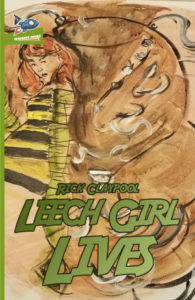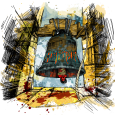Recently, I was asked to write an advance review for a forthcoming science fiction novel from a small press. I jumped at the opportunity to read the book before fully contemplating if it would be worth the time. Smaller presses are always a gamble in terms of quality, both with the writing and the printing, so for all I knew I was in for a terrible reading experience. I decided to plow through with the review anyway and soon found Leech Girl Lives by Rick Claypool and Spaceboy Books in my inbox. So, were my fears justified or was Leech Girl Lives worth the effort of a read through?
 Leech Girl Lives takes place in a dystopian future where the majority of humanity has died out and what’s left live in a domed city called the Bublinaplex. While the Bublinaplex is surrounded by a “Fungus Wasteland” filled with large, horrendous and terrifying creatures, the people have managed to build a pretty stable world which is overly concerned with safety. This is where our protagonist comes in.
Leech Girl Lives takes place in a dystopian future where the majority of humanity has died out and what’s left live in a domed city called the Bublinaplex. While the Bublinaplex is surrounded by a “Fungus Wasteland” filled with large, horrendous and terrifying creatures, the people have managed to build a pretty stable world which is overly concerned with safety. This is where our protagonist comes in.
Margo Chicago is an Art Safety Inspector who investigates all works of art put on display to ensure that the artwork doesn’t hurt anyone. She has a fairly important job because the denizens of the Bublinaplex are all encouraged to work on some sort of “creative pursuit.” Some of these are worthwhile, like painting and singing while others, like Margo’s desire to crochet cats, are a little offbeat. Others still are just asinine, like Margo’s boss and his creativity in stringing nonsense words together in everyday conversations.
Due to a freak accident, Margo gets a pair of giant parasitic leeches attached to her arms. The leeches slowly eat away at her flesh and, through their symbiotic nature, become her new arms. It’s a unique concept. Although it sounded strange at first and had me questioning what kind of book I was reading, eventually the idea settled in and just flowed with the narrative. I wouldn’t have imagined that I’d enjoy a concept like that but I surely did.
Leech Girl Lives is author Rick Claypool’s first novel and that’s fairly evident in the way the book is written. Claypool builds his world and presents his novel using simple prose, which I liked. Lots of science fiction authors use long, flourishing prose and convoluted sentence structure that may sound pretty but can be confusing when trying to build an in-depth world. Claypool shirks that and just lays everything out on the table in easy bits for the layman. Whether this was intentional or just a byproduct of not finding his unique voice yet, I’m not entirely sure but the move worked in this instance.
One move that was intentional was the way Claypool split the chapters for the first third of the book. Each chapter vacillates between “Earlier” and “Later,” clearly delineating two different time periods. It’s an effective strategy that made the story more enticing; each time I finished one section, I wanted to find out what happened next but I had to read through a different section that piqued my interest just as much. Unfortunately, once the two sections converge, the story runs somewhat flat. It managed to remain interesting, but it lacked the oomph of the previous section.
The novel is also split into two distinct books, named Book One and Book Two. While I enjoyed Leech Girl Lives in its entirety, I did start to feel weighed down by the time I got to Book Two. It’s not that the second part wasn’t good; it’s just that I’d become burned out by the time I got there. I’d already gone through an entire adventure with Margo and her leech arms so to be thrown into another one right away was exhausting. I would have preferred if Leech Girl Lives ended at the first ending, with Book Two comprising an actual second book.
Doing so would have also allowed Claypool to expand on some of the themes he brings up in Book Two. While Book One dealt with the idea of stifling expression through the Art Safety’s mission to have artists alter any work they deem unsafe, Book Two explores the idea of a corporate run state as well as the division between the rich and the poor. By day, Rick Claypool is an activist who works with an organization that fights corporate power so if there would be anyone who can successfully integrate the dangers of a corporate state taking power in a silly little sci fi book, it’d be him. The way he breaks down the company’s rise to power makes us believe that the city would accept the corporate power, but everything that happens in Book Two happens so fast that it almost comes off as hokey despite the gravity of the theme. Claypool spends too much time focusing on scenes that don’t have much of an impact while breezing through others that are far more interesting. Characters speak in awkward, unnatural ways and the action doesn’t serve the plot but merely acts to hasten the transition to the next scene. I would have enjoyed it more if he slowed down and delved further into this new world he’s introduced. Allowed us to get to know a few of the newer characters better and see why they do what they do and how the corporation changed them from their previous lives.
The characterization is really the weakest part of Leech Girl Lives. Claypool focuses on Margo and spends a lot of time making sure she’s as fleshed out as possible, which is to be expected of the protagonist. Unfortunately he does this to the detriment of the supporting cast. Margo is surrounded by many unique and interesting people but they never feel whole. For example, Margo has a great relationship with her mentor, Cuthbert. Though we get a peak at Cuthbert’s home life, all we really know about him is he’s a great cook and he cries a lot. Even the book’s main protagonist, Lorcan Warhol, is a two-dimensional foil to Margo. Sure, his character takes an interesting twist during Book Two, but at a certain point he disappears and has no impact on the rest of the book. He had the makings of an interesting character but he’s flung off without a second thought.
I enjoyed Leech Girl Lives. The simple prose aside, the book played with some deep sociological themes and really dived into the darker aspects of society. Even the superficial nature of Margo’s affliction, forming a symbiotic relationship with a pair of parasitic leeches, was handled in a way that felt natural and believable. That’s not to say the book doesn’t have its flaws; in fact, there are quite a few of them, but they’re easily overshadowed by the depth of the symbolism. All in all, I’d recommend Leech Girl Lives if you’re looking for a fun adventure that doesn’t require too much brain power to really understand and enjoy.
Leech Girl Lives by Rick Claypool is available on September 26th from Spaceboy Books.
Grade: B-











